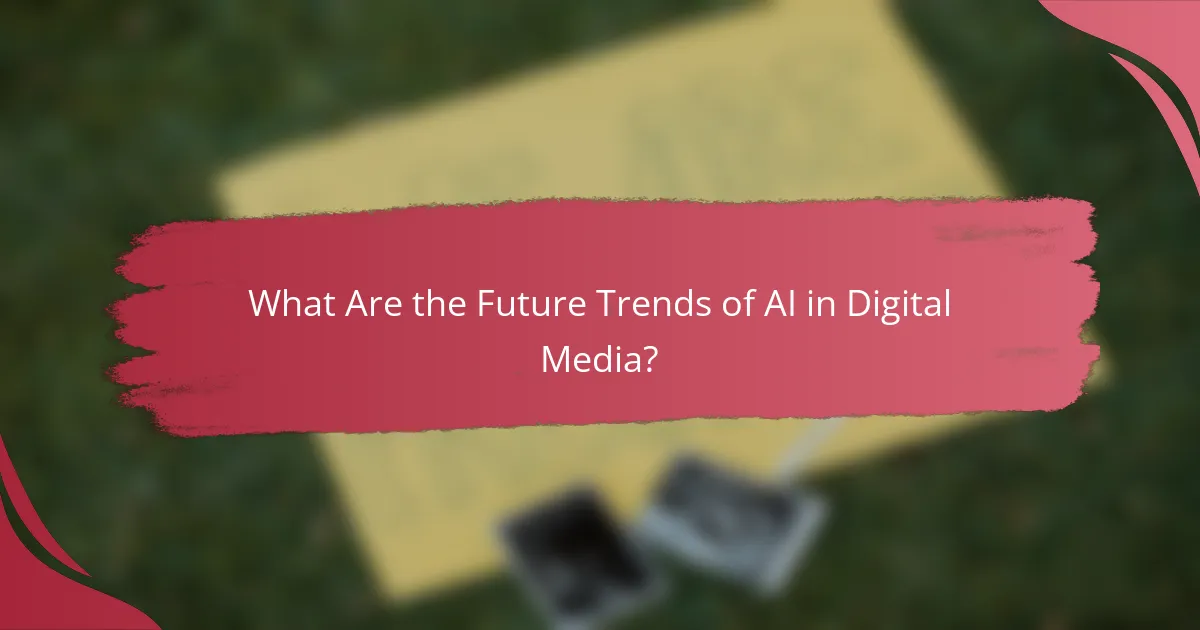AI is transforming digital media trends by enhancing personalization and automating content creation, allowing companies to deliver more relevant and engaging experiences to users. With improved audience targeting and real-time analytics, businesses can make informed decisions and optimize their operations. However, this shift also brings challenges related to data privacy and content authenticity, which must be addressed to maintain user trust and regulatory compliance.

How Is AI Transforming Digital Media Trends?
AI is significantly reshaping digital media trends by enhancing personalization, automating content creation, improving audience targeting, and providing real-time analytics. These advancements enable media companies to deliver more relevant content to users, streamline production processes, and make data-driven decisions.
Enhanced content personalization
AI enhances content personalization by analyzing user behavior and preferences to deliver tailored experiences. For example, streaming services like Netflix use algorithms to recommend shows based on viewing history, increasing user engagement and satisfaction.
To implement effective personalization, businesses should collect data responsibly and ensure compliance with privacy regulations like GDPR. Utilizing machine learning models can help predict user interests and improve content relevance.
Automated content creation
Automated content creation leverages AI tools to generate articles, videos, and social media posts with minimal human intervention. Platforms like OpenAI’s GPT can produce written content quickly, allowing media companies to scale their output efficiently.
While automation can save time, it is crucial to maintain quality and authenticity. Businesses should consider using AI-generated content as a draft, refining it with human oversight to ensure it aligns with brand voice and standards.
Improved audience targeting
AI improves audience targeting by analyzing vast amounts of data to identify specific demographics and behaviors. This allows marketers to create highly targeted campaigns that resonate with particular audience segments, leading to higher conversion rates.
For effective targeting, companies should utilize AI-driven tools to segment their audience based on interests, purchasing behavior, and engagement patterns. Regularly updating these segments can help maintain relevance in a rapidly changing digital landscape.
Real-time analytics and insights
Real-time analytics powered by AI provide immediate insights into audience behavior and content performance. This enables media companies to make quick adjustments to their strategies, optimizing campaigns for better results.
To leverage real-time analytics, businesses should invest in AI tools that track key performance indicators (KPIs) such as engagement rates and click-through rates. Setting up dashboards can help visualize data trends and facilitate timely decision-making.

What Are the Key Benefits of AI in Digital Media?
AI significantly enhances digital media by improving user engagement, optimizing advertising costs, and enabling scalable content production. These benefits help businesses adapt to changing consumer preferences and streamline their operations.
Increased engagement rates
AI tools analyze user behavior to tailor content, resulting in higher engagement rates. By leveraging algorithms that predict user preferences, brands can deliver personalized experiences that resonate with their audience.
For instance, streaming platforms use AI to recommend shows based on viewing history, leading to longer watch times and increased subscriber retention. This targeted approach can boost engagement metrics by tens of percent.
Cost efficiency in ad spending
AI optimizes ad spending by analyzing performance data to allocate budgets more effectively. It can identify which ads perform best and adjust spending in real-time, ensuring that every dollar is used efficiently.
For example, programmatic advertising platforms utilize AI to automate ad placements, reducing costs associated with manual processes. Businesses can expect to see a reduction in cost-per-click (CPC) by a significant margin when employing these technologies.
Scalability of content production
AI enables businesses to scale content production without a proportional increase in resources. Automated content generation tools can create articles, social media posts, and even videos, allowing brands to maintain a consistent online presence.
Companies can utilize AI-driven platforms to produce hundreds of pieces of content quickly, meeting the demands of various channels. This scalability is particularly beneficial for small to medium enterprises looking to compete with larger players in the digital space.

What Challenges Does AI Present in Digital Media?
AI presents several challenges in digital media, primarily concerning data privacy, content authenticity, and increasing dependence on technology. These issues can impact user trust, regulatory compliance, and the overall quality of media produced.
Data privacy concerns
Data privacy is a significant challenge as AI systems often require vast amounts of personal information to function effectively. This raises concerns about how data is collected, stored, and used, especially in light of regulations like GDPR in Europe, which imposes strict guidelines on data handling.
Organizations must ensure they have robust data protection measures in place. This includes obtaining explicit consent from users and being transparent about data usage. Failing to address these concerns can lead to legal repercussions and loss of consumer trust.
Content authenticity issues
AI-generated content can blur the lines between genuine and fabricated information, leading to authenticity issues. As AI tools become more sophisticated, distinguishing between human-created and machine-generated content becomes increasingly difficult.
To combat this, media companies should implement verification processes for content authenticity. Using watermarking or metadata can help indicate the origin of content, ensuring that audiences can trust what they consume.
Dependence on technology
As digital media increasingly relies on AI, there is a growing concern about over-dependence on technology. This reliance can lead to reduced creativity and critical thinking among content creators, as they may lean too heavily on AI tools for production.
To mitigate this risk, it is essential for creators to balance AI assistance with human creativity. Encouraging a hybrid approach can foster innovation while maintaining the unique perspectives that human creators bring to the table.

How Can Brands Leverage AI for Advertising?
Brands can leverage AI for advertising by utilizing advanced technologies to enhance targeting, personalization, and efficiency in their campaigns. By integrating AI tools, companies can analyze consumer behavior and optimize their advertising strategies in real-time, leading to better engagement and higher conversion rates.
Programmatic advertising solutions
Programmatic advertising automates the buying and selling of ad space, allowing brands to target specific audiences more effectively. Using AI algorithms, advertisers can analyze vast amounts of data to identify the best times and platforms for ad placements, optimizing their spending.
Brands should consider using demand-side platforms (DSPs) that leverage AI to enhance their programmatic strategies. These platforms can help in real-time bidding, ensuring that ads reach the right audience at the right moment, which can significantly improve return on investment (ROI).
Predictive analytics for campaign optimization
Predictive analytics uses historical data and AI to forecast future trends and consumer behaviors, enabling brands to refine their advertising campaigns. By analyzing past performance, brands can identify which strategies are likely to succeed and adjust their campaigns accordingly.
To effectively implement predictive analytics, brands should focus on collecting high-quality data and utilizing machine learning models that can adapt to changing market conditions. Regularly reviewing and updating these models can help maintain their accuracy and relevance, ensuring that campaigns remain effective over time.

What Are the Future Trends of AI in Digital Media?
Future trends of AI in digital media focus on enhancing user experience and content delivery through advanced technologies. Key developments include the integration of augmented reality and voice search optimization, which are reshaping how audiences interact with digital content.
Integration of augmented reality
Augmented reality (AR) is increasingly being integrated into digital media to create immersive experiences. This technology overlays digital information onto the real world, allowing users to engage with content in a more interactive manner. For instance, brands can use AR in advertising campaigns to let customers visualize products in their own environment before making a purchase.
When implementing AR, consider the user interface and accessibility. Ensure that the AR experience is intuitive and does not require extensive technical knowledge. Additionally, focus on high-quality visuals to maintain engagement and avoid common pitfalls like lag or poor tracking, which can detract from the experience.
Voice search optimization
Voice search optimization is becoming essential as more users rely on voice-activated devices for information retrieval. This trend requires digital media creators to adapt their content strategies to include natural language processing and conversational keywords. For example, optimizing for voice search often means focusing on longer, question-based phrases rather than short, keyword-centric queries.
To effectively optimize for voice search, prioritize content that answers common questions and provides clear, concise information. Use structured data to help search engines understand your content better. Avoid jargon and ensure that your content is easily digestible, as voice search users typically seek quick, straightforward answers.



